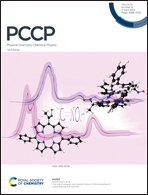Ab initio studies on graphyne (GY) for the detection of rare bases in DNA†
Abstract
Graphyne (GY) and functionalized GY have become cutting-edge research materials for the scientific community. In the present work, the adsorption of rare bases -cytosine (Cyt), 5-methylcytosine (5-meCyt), 5-hydroxymethylcytosine (5-hmCyt), 5-formoxylcytosine (5-fCyt), and 5-carboxylcytosine (5-caCyt) on pristine, B- and N-doped γ-GY was investigated by the first-principles density functional method; methods were designed to distinguish these rare bases by the translocation time and sensitivity. Initially, the stability of pristine, B- and N-doped γ-GY was ascertained by the cohesion energy, and the electronic properties were also analyzed by the energy gap and density of state (DOS). When adsorbing over pristine γ-GY, the translocation times of rare bases were 1.34 × 101, 4.71 × 101, 1.19 × 104, 3.77 × 10−1 and 1.93 × 101 s, respectively. The sensitivities were 2.19%, 0.88%, 0.22%, 2.41%, and 0.88%, respectively, which indicates that they were not clearly separated. By doping the impurity atom, the electronic properties can be fine-tuned to change their selectivity. When adsorbing on the B-doped γ-GY, these rare bases showed sensitivities of 24.69%, 27.20%, 43.32%, 29.97%, and 32.24%, respectively. The rare bases showed sensitivities of 10.15%, 9.02%, 17.29%, 0.38%, and 3.76%, respectively, when adsorbing over the N-doped γ-GY, which greatly increases selectivities for recognization. Thus, these results indicate that pristine and doped γ-GY, as the electrical sensing material, can be used to detect rare bases.



 Please wait while we load your content...
Please wait while we load your content...